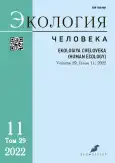Evaluation of the effectiveness of technological measures to manage the risk to public health when exposed to atmospheric emissions of multi-fuel combined heat and power plants
- Authors: Petrov S.B.1, Zhernov Y.V.2
-
Affiliations:
- Kirov State Medical University
- I.M. Sechenov First Moscow State Medical University (Sechenov University)
- Issue: Vol 29, No 11 (2022)
- Pages: 761-770
- Section: ORIGINAL STUDY ARTICLES
- URL: https://journals.rcsi.science/1728-0869/article/view/233086
- DOI: https://doi.org/10.17816/humeco110989
- ID: 233086
Cite item
Full Text
Abstract
AIM: To assess the effectiveness of technological measures to manage the risk to public health of exposure to atmospheric emissions from multi-fuel combined heat and power plants (CHP).
METHODS: The study involved modeling the dispersion of emissions from the thermal power plants, calculation of surface concentrations, assessment of carcinogenic and non-carcinogenic risks to public health, and estimating the relative risk of mortality, referrals and hospitalizations based on WHO guidelines on atmospheric air quality. Predictive scenarios were constructed for thermal power plants, including the initial state, modernization with the help of technological and sanitary measures, and changes in the structure of the fuel balance.
RESULTS: The use of low-temperature vortex fuel combustion technology in combination with a modernized dust and gas cleaning system significantly (p <0.001) decreased the predicted carcinogenic risk index by an average of 80.67%, non-carcinogenic risk index by 78.84%, and relative mortality risks and referrals to medical organizations by more than 80%. The use of a gas turbine plant increased the production of electric energy by 72.23%, thermal energy by 4.89%, and significantly (p <0.001) reduced the level of carcinogenic risk by 44–60%, non-carcinogenic risk by 35–47%, and relative risks of mortality, visits to medical organizations and hospitalizations by 33–64%.
CONCLUSION: The use of the best available technologies to modernize multi-fuel CHP plants significantly reduces the level of risk to public health while it increases the production of electric and thermal energy and maintaining the advantage of using both solid and gaseous fuels.
Full Text
##article.viewOnOriginalSite##About the authors
Sergey B. Petrov
Kirov State Medical University
Author for correspondence.
Email: sbpetrov@mail.ru
ORCID iD: 0000-0002-2592-4432
SPIN-code: 4437-0407
MD, Cand. Sci. (Med.), associate professor
Russian Federation, 112, K. Marksa street, Kirov, 610998Yury V. Zhernov
I.M. Sechenov First Moscow State Medical University (Sechenov University)
Email: zhernov@list.ru
ORCID iD: 0000-0001-8734-5527
SPIN-code: 4538-9397
MD, Dr. Sci. (Med.), professor
Russian Federation, MoscowReferences
- Avaliani SL, Bushtueva KA, Golub AA. Mediko-demograficheskaja ocenka vygod ot snizhenija vybrosov parnikovyh gazov. In: Izmenenie klimata i zdorov'e naselenija Rossii v HHІ veke: cb. mater. mezhdunar. seminara; 2004 Apr 5–6; Moscow: Izdatel'skoe tovarishchestvo “Adamant”; 2004. P. 185–194. (In Russ).
- Revich BA. Assessment of the effect produced by the fuel and energy complex on the environment and health. Studies on Russian Economic Development. 2010;21(4):403–410. (In Russ).
- Petrov SB. Mediko-jekologicheskaja ocenka rajona razmeshhenija predprijatij teplojenergetiki. Izvestija Samarskogo nauchnogo centra Rossijskoj akademii nauk. 2008;1:209. (In Russ).
- Kulikov MA, Gavrilov EI, Demin VF, Zakharchenko IE. Risks relating to the effect of atmospheric emissions from thermal power stations on health of the population. Thermal Engineering. 2009;(56)1:78–85. (In Russ).
- Rakitskii VN, Kuz'min SV, Avaliani SL, et al. Contemporary challenges and ways to improve health risk assessment and management. Health Risk Analysis. 2020;(3):22–28. (In Russ). doi: 10.21668/health.risk/2020.3.03
- Rezinskih VF, Grin' EA. Nadezhnost' i bezopasnost' TJeS Rossii na sovremennom jetape: problemy i perspektivnye zadachi. Teploenergetika. 2010;(1):2–9. (In Russ).
- Brunekreef B, Holgate ST. Air pollution and health. Lancet. 2002;360(9341):1233–1242. doi: 10.1016/S0140-6736(02)11274-8
- WHO global air quality guidelines. Particulate matter (PM2.5 and PM10), ozone, nitrogen dioxide, sulfur dioxide and carbon monoxide. Geneva: World Health Organization; 2021.
- Halafjan AA. Sovremennye statisticheskie metody medicinskih issledovanij. Moscow: Izdatel'stvo LKI; 2008. 320 p. (In Russ).
- Friedrich R, Rabl A, Spadaro JV. Quantifying the costs of air pollution: the ExternE project of the EC. Pollution Atmosphérique. 2001;77–104.
- Zhu Q, Luo X, Zhang B, Chen Y, et al. Mathematical modeling, validation, and operation optimization of an industrial complex steam turbine network-methodology and application. Energy. 2016;97(C):191–213. doi: 10.1016/j.energy.2015.12.112
- Peng RD, Bell ML, Geyh AS, et al. Emergency admissions for cardiovascular and respiratory diseases and the chemical composition of fine particle air pollution. Environ Health Perspect. 2009;117(6):957–963.
- Grigoriev KA, Skuditsky VE, Zykin YV. Application of low-temperature vortical combustion of different fuels in the steam-boiler BKZ-210-13,8 at Kirov CHP-4. Power Technology and Engineering. 2010;(4):9–13. (In Russ).
- Aminov RZ, Garievsky MV. The efficiency of combined-cycle CHP plant with variable electric loads, taking into account the wear and tear of equipment. Power Engineering: Research, Equipment, Technology 2018;(7-8):10–22. (In Russ).
Supplementary files







